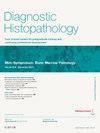Immunohistochemistry for prediction of response to immunotherapy
引用次数: 0
Abstract
For almost a decade predicting the response of malignant tumours to treatment with immunotherapies has been dependent on PD-L1 expression by immunohistochemistry. Much has been learned about the uniquely challenging application of PD-L1 immunohistochemistry which is utilized in a constantly expanding array of tumour types and clinical contexts. More recently, other predictive biomarkers have acquired clinical validation including tumour mismatch repair deficiency. In this short review, I will assess the strengths and weaknesses of PD-L1 immunohistochemistry, including pre-analytics, analytics and post-analytics in the context of the complex underlying biology. In doing so, I hope to provide some practical guidance that will help optimize its application in routine practice. I will also highlight the various contexts in which immunohistochemistry for PD-L1 and mis-match repair is used to predict response to immunotherapies and how ongoing developments of novel immunohistochemistry based biomarkers might assist in strengthening the ability to predict response to immunotherapies.
用于预测免疫疗法反应的免疫组化技术
近十年来,通过免疫组化方法预测恶性肿瘤对免疫疗法的反应一直依赖于 PD-L1 的表达。PD-L1 免疫组化的应用具有独特的挑战性,在不断扩大的肿瘤类型和临床环境中得到了广泛应用。最近,其他预测性生物标志物也获得了临床验证,包括肿瘤错配修复缺陷。在这篇简短的综述中,我将评估 PD-L1 免疫组化的优缺点,包括在复杂的基础生物学背景下的分析前、分析中和分析后。在此过程中,我希望能提供一些实用指导,帮助优化其在常规实践中的应用。我还将重点介绍免疫组化PD-L1和错配修复用于预测免疫疗法反应的各种情况,以及基于免疫组化的新型生物标记物的不断发展如何有助于加强预测免疫疗法反应的能力。
本文章由计算机程序翻译,如有差异,请以英文原文为准。
求助全文
约1分钟内获得全文
求助全文
来源期刊

Diagnostic Histopathology
Medicine-Pathology and Forensic Medicine
CiteScore
1.30
自引率
0.00%
发文量
64
期刊介绍:
This monthly review journal aims to provide the practising diagnostic pathologist and trainee pathologist with up-to-date reviews on histopathology and cytology and related technical advances. Each issue contains invited articles on a variety of topics from experts in the field and includes a mini-symposium exploring one subject in greater depth. Articles consist of system-based, disease-based reviews and advances in technology. They update the readers on day-to-day diagnostic work and keep them informed of important new developments. An additional feature is the short section devoted to hypotheses; these have been refereed. There is also a correspondence section.
 求助内容:
求助内容: 应助结果提醒方式:
应助结果提醒方式:


